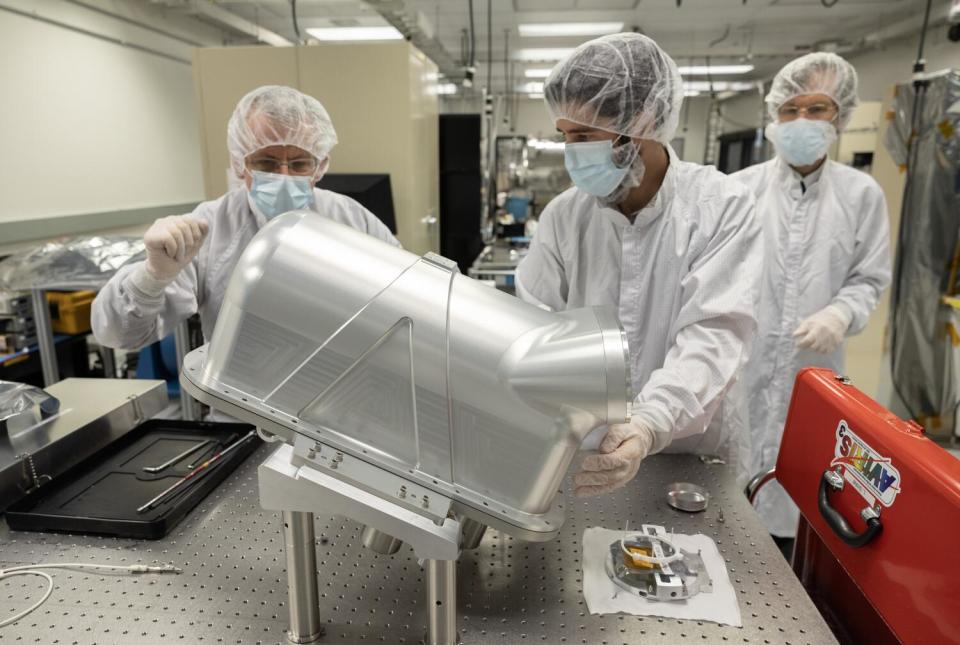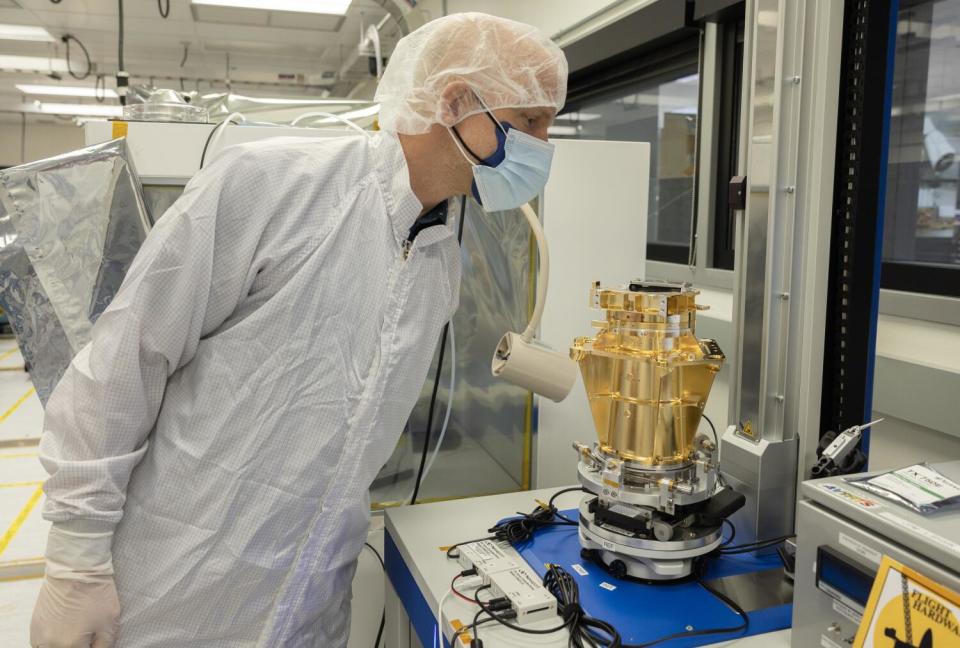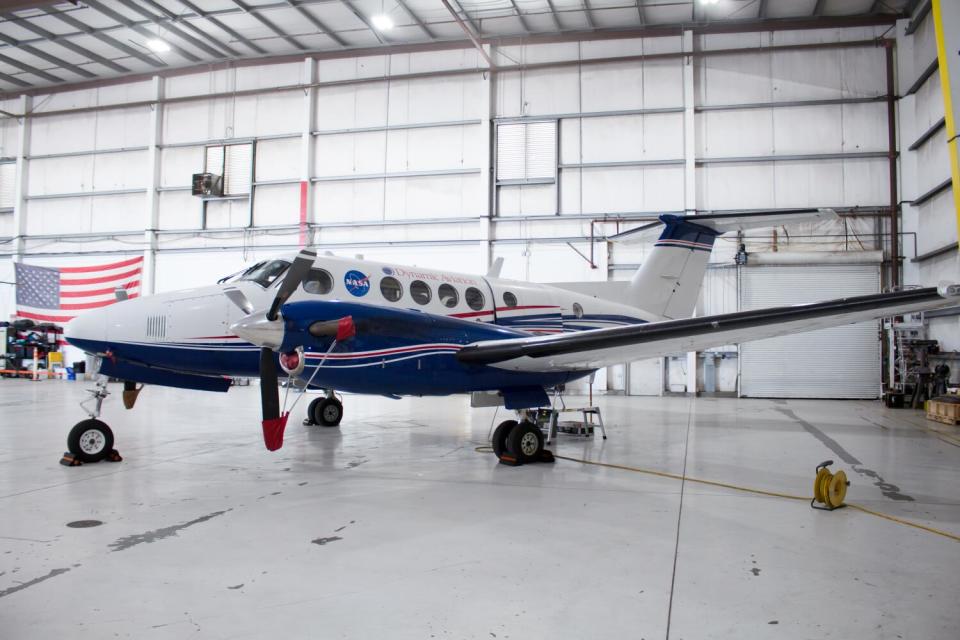It was almost 10 years ago that Andrew Thorpe received a text message from the crew flying over the ship in a small plane: they had discovered a new methane hotbed.
Thorpe drove a clumsy rental car over winding dirt roads and mountain roads near the Four Corners region of the southwestern United States. When he arrived at the spot he had reported from the plane, he grabbed a thermal camera to scan the plume. Sure enough, methane was seeping from the ground, likely from a leaking pipeline.
He saw a marker sticking out of the desert with a gas company phone number, so he called them. “I had the most confused person on the other end of the phone,” Thorpe said. “I tried to explain to them why I was calling, but this was years ago when there was no technology to do this.”
Over the years, Thorpe’s work has earned him unwanted attention. “I’ve taken some driver’s tests in California … A hired gun was very suspicious of me and tried to scare me off,” Thorpe said. “When you put a thermal camera on a public road and you point it at a tank behind the fence, people get nervous. I’ve been booed by a couple of oil and gas workers, but that’s normal.”
Today, Thorpe is part of a group leading the way in greenhouse gas monitoring at NASA’s Jet Propulsion Laboratory in La Cañada Flintridge. For more than 40 years, the Microdevices Laboratory at JPL has been developing specialized instruments to measure methane and carbon dioxide with extreme precision.
The instruments, called spectrometers, detect gases based on what colors of sunlight they absorb. Earlier this year, a team of researchers from JPL, Caltech and nonprofit research organization Carnegie Science was selected as a finalist for a NASA award to put the technology into orbit.

If the team is chosen for the satellite mission, the team’s carbon survey, called Carbon-I, would begin in the early 2030s. Over three years, Carbon-I would continuously map greenhouse gas emissions around the world, taking daily snapshots of areas of interest, allowing scientists to identify sources of climate pollution such as power plants, pipeline leaks, farms and landfills.
While there are already several satellites monitoring these gases, Carbon-I’s resolution is unprecedented and would take the guesswork out of determining where the gas was emitted. “There’s no denying it anymore: Once we see a plume, there’s no other potential source,” said Christian Frankenberg, co-principal investigator for Carbon-I and a professor of environmental science and engineering at Caltech.


Carbon-I’s best resolution, 100 feet, “is very high resolution from space. That’s an incredible resolution to be able to do,” said Debra Wunch, a professor at the University of Toronto who studies the Earth’s carbon cycle and is not involved in the Carbon-I proposal. “It could give us much more insight into the exact source of emissions. … This would be groundbreaking. You could actually see individual piles, individual sections of landfills.”
Historically, monitoring greenhouse gas emissions from individual emitters has been challenging: Both carbon dioxide and methane are colorless and odorless. As a result, scientists have often had to rely on adding together self-reported values from companies and estimates from research. For example, to estimate the amount of methane produced by cows, scientists would have to determine how much methane one cow emits and multiply that by the total number of cows on Earth.
“If you look at international policies … right now they’re all based on these bottom-up inventories,” said Anna Michalak, co-principal investigator for Carbon-I and founding director of the Carnegie Climate and Resilience Hub at Carnegie Science. “We need to get to a point where … we actually have an independent way of tracking what the emissions are.”
Carbon-I’s resolution will also give scientists new access to the atmosphere of the tropics, where clouds currently obscure most forms of satellite monitoring. “It’s their Achilles heel,” Frankenberg said.
Because tropical and subtropical forests absorb about a quarter of the CO2 humanity produces The burning of fossil fuels creates an urgent need for accurate data from this part of the world.
Satellites currently orbiting Earth at lower resolutions cannot see through small gaps in cloud cover. They see only a fuzzy average of the cloudy and clear patches in the sky for each pixel. Carbon-I, with a pixel area nearly 50 times smaller than most other satellites, can see the gaps and take measurements through them. In a April 2024 paperFrankenberg, Michalak and their collaborators estimate that Carbon-I could see through clouds in the tropics 10 to 100 times more often than its predecessors.
Carbon-I “is going to see things that people don’t know are happening,” said Thorpe, who left his postdoctoral studies to point thermal cameras at gas leaks and now works as a research technologist at the Microdevices Laboratory. “It’s going to open up a whole new area of science.”
JPL’s airborne greenhouse gas monitoring program goes back decades, but the field of space monitoring is still relatively new. In early 2016, NASA Headquarters contacted the JPL team. There was an ongoing massive eruption at Aliso Canyon gas storage facility at Porter Ranch, and NASA wanted the team to investigate.
The team flew over the site for three days over the course of a month in a 1960s-era spy plane as the Southern California Gas Co. fought to stop the eruption. At the same time, NASA’s Goddard Flight Center in Maryland trained the NASA Earth Observing spacecraft’s Hyperion spectrometer on the leak.
Hyperion was designed to make observations of the Earth’s surface and filter out noise from the atmosphere. Now they were trying to observe the atmosphere and filter out the surface, and for the first timescientists observed a man-made source of methane from space.
“The Hyperion result was quite noisy, but you could still see the plume,” Thorpe said. “This was really a proof of concept that we could do it from space.”
Even when Carbon-I launches, the team won’t stop putting instruments on planes. From planes, the team can monitor areas of interest at even sharper resolution and for days at a time. Right now, a leaner, meaner version of the spectrometers that observed the Four Corners leak and the Aliso Canyon blowout is flying a series of missions to monitor emissions from offshore oil platforms in the Gulf of Mexico.


Aircraft missions also give the team a chance to try out new and improved spectrometers. “You can fix them, and you can upgrade them,” said JPL engineer Michael Eastwood, who has worked with the spectrometers for more than three decades and flies them regularly. “You can take more risks, unlike spacecraft that need to be really mature, really known, high reliability — we’re not as constrained.”
The air team is also agile. Typically, two crew members sit in the second row of a twin-propeller King Air plane, staring at a stack of laptops and instruments with enough buttons to rival the plane’s cockpit. On the screens, they can view real-time GPS data and spectrometer readings and coordinate a flight plan with the pilots. The spectrometer — called AVIRIS, short for Airborne Visible/Infrared Imaging Spectrometer — sits in the third row, looking down through a window cut into the floor.
The NASA program for which Carbon-I was selected as a finalist is focused on funding space-based Earth sciences that benefit society. The team was awarded $5 million to refine its project proposal before a final NASA review in 2025. There are three other finalists, and two will be selected for launch.
This two-step process for selecting missions is new to NASA’s Earth science programs and requires JPL to compete with the rest of the scientific community, regardless of its association with the space agency.
“When we talk about money for groceries, [$5 million] “It seems like a lot of money, but it’s a real bargain,” Michalak said. “When you think you’re spending $300 million on a mission, it’s really smart to spend 1.5% of that to really make sure it’s going to be fantastic and successful.”
In the meantime, the Carbon-I team is focused on demonstrating to NASA that it has the technical expertise to complete the project on time and on budget.
“I think all four missions at the current stage are absolutely worthwhile as science missions,” Michalak said, “and the chance that it will be a satellite mission is 50 percent.”
This story originally appeared in the Los Angeles Times.